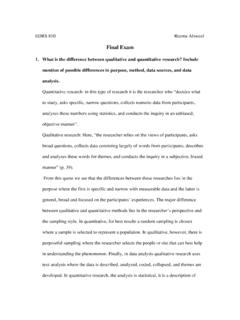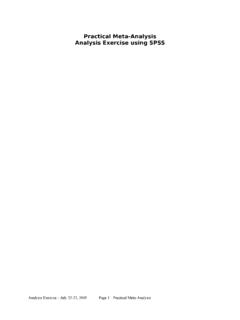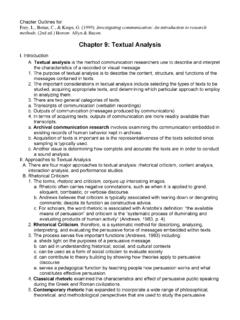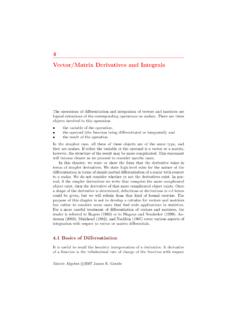Transcription of Chapter 14: Analyzing Relationships Between Variables
1 Chapter Outlines for: Frey, L., Botan, C., & Kreps, G. (1999). Investigating communication: An introduction to research methods. (2nd ed.) Boston: Allyn & Bacon. Chapter 14: Analyzing Relationships Between Variables I. Introduction A. This Chapter examines how two or more Variables may be related: It starts by considering the relationship Between two Variables (bivariate association) and then expands to consider more Variables . B. The Chapter examines the types of possible Relationships Between Variables , explains how Relationships are analyzed statistically, shows how relationship analysis is used to make predictions, and introduces some advanced statistical relationship analyses used in communication research.
2 II. Types of Relationships A. A scatter plot (scattergram or scatter diagram) is a visual image of the ways in which Variables may or may not be related. B. Two Variables can be associated in one of three ways: unrelated, linear, or nonlinear . 1. Unrelated Variables have no systematic relationship ; changes in one variable simply are not related to the changes in the other variable . 2. Linear Relationships Between Variables can generally be represented and explained by a straight line on a scatter plot. a. There are two types of linear Relationships : positive and negative i. Positive relationship : Two Variables move, or change, in the same direction. ii. Negative relationship : Two Variables move in opposite directions.
3 3. nonlinear Relationships Between Variables can be represented and explained by a line on a scatter plot that is not straight, but curved in some way. a. A curvilinear relationship is described by a polynomial equation, which means that it takes at least one curve, or turn, to represent the data on a scatter plot. i. A quadratic relationship is a curvilinear relationship that has only one curve in it, while cubic, quartic, and quintic Relationships describe even more complex Relationships Between Variables . b. A U-shaped curvilinear relationship means that two Variables are related negatively until a certain point and then are related positively. c. An inverted U-shaped curvilinear relationship means that two Variables are related positively to a certain point and then are related negatively.
4 III. Correlations: Statistical Relationships Between Variables A. A statistical relationship Between Variables is referred to as a correlation 1. A correlation Between two Variables is sometimes called a simple correlation. 2. The term measure of association is sometimes used to refer to any statistic that expresses the degree of relationship Between Variables . 3. The term correlation ratio (eta) is sometimes used to refer to a correlation Between Variables that have a curvilinear relationship . B. To determine the statistical correlation Between two Variables , researchers calculate a correlation coefficient and a coefficient of determination. 1. Correlation coefficient: A correlation coefficient is a numerical summary of the type and strength of a relationship Between Variables .
5 A. A correlation coefficient takes the form: rab = +/-x, where r stands for the correlation coefficient, a and b represent the two Variables being correlated, the plus or minus sign indicates the direction of the relationship Between the Variables (positive and negative, respectively), and x stands for some numerical value. i. The first part is the sign (+ or -), which indicates the direction (positive or negative) of the relationship Between the Variables of interest. ii. The second part is a numerical value that indicates the strength of the relationship Between the variable ; this number is expressed as a decimal value that ranges from + (a perfect positive relationship ) to (a perfect negative relationship ); a correlation coefficient of means two Variables are unrelated, at least in a linear manner.
6 B. Interpreting correlation coefficients: interpreting the importance of or strength of a correlation coefficient depends on many things, including the purpose and use of the research and sample size. c. Calculating correlation coefficients: Researchers use a variety of statistical procedures to calculate correlation coefficients Between two Variables , depending on how the two Variables are measured. i. Relationships Between ratio/interval Variables can be assessed in the following ways. (a) The Pearson product moment correlation calculates a correlation coefficient for two Variables that are measured on a ratio or interval scale. (b) The point biserial correlation (rpb) is used when researchers measure one variable using a ratio/interval scale and the other variable using a nominal scale.
7 Ii. Relationships Between ordinal Variables can be assessed in the following ways. (a) The Spearman rho correlation can be used to compare two sets of ranked scores for the same group of research participants, or the ranked scores of various items by two different groups might be compared. (b) Kendall s correlation (tau), which refers to three measures of association and is used in lieu of a Spearman rho correlation coefficient, typically when a researcher has a pair of ranks for each of several individuals. iii. The procedures for computing a correlation coefficient Between nominal Variables , such as Cramer s V, are based on the chi-square value associated with the two- variable chi-square test. d. Correlation matrices: A correlation matrix lists all the relevant Variables across the top and down the left side of a matrix where the respective rows and columns meet, researchers indicate the bivariate correlation coefficient for those two Variables and whether it is significant by using stars (such as one star for significance at the.)
8 05 level) or in a note that accompanies the matrix. e. Causation and correlation: Correlation is one of the criteria used to determine causation, but causation cannot necessarily be inferred from a correlation coefficient. i. Researchers can sometimes use the sequencing of events in time to infer causation. ii. Two Variables may also be correlated, but their relationship is not necessarily meaningful. 2. Coefficient of Determination: A coefficient of determination (r-squared) is a numerical indicator that tells how much of the variance in one variable is associated, explained, or determined by another variable . a. A coefficient of determination rages from to and is found by squaring the correlation coefficient.
9 B. Researchers must pay careful attention to the correlation of determination when interpreting the results of the correlation coefficients found in their studies. 3. Multiple correlation: A multiple correlation is computed when researchers want to assess the relationship Between the variable they wish to explain, the criterion variable , and two or more other independent Variables working together; and the procedure yields two types of statistics. a. A multiple correlation coefficient is just like a correlation coefficient, except that it tells researchers how two or more Variables working together are related to the criterion variable of interest. i. A multiple correlation coefficient indicates both the direction and the strength of the relationship Between a criterion variable and the other Variables .
10 Ii. Takes the form = +/-x, read The multiple correlation of Variables b and c with variable a (the criterion variable is .. b. A coefficient of multiple determination (R-squared, R2) expresses the amount of variance in the criterion variable that can be explained by the other Variables acting together; it is computed by squaring the multiple correlation coefficient. i. The coefficient of nondetermination is that part of the variance in the criterion variable that is left unexplained by the independent Variables , symbolized and calculated as 1-R2. 4. Partial Correlation: A partial correlation explains the relationship Between two Variables while statistically controlling for the influence of one or more other Variables (sometimes called effects analysis or elaboration).)












